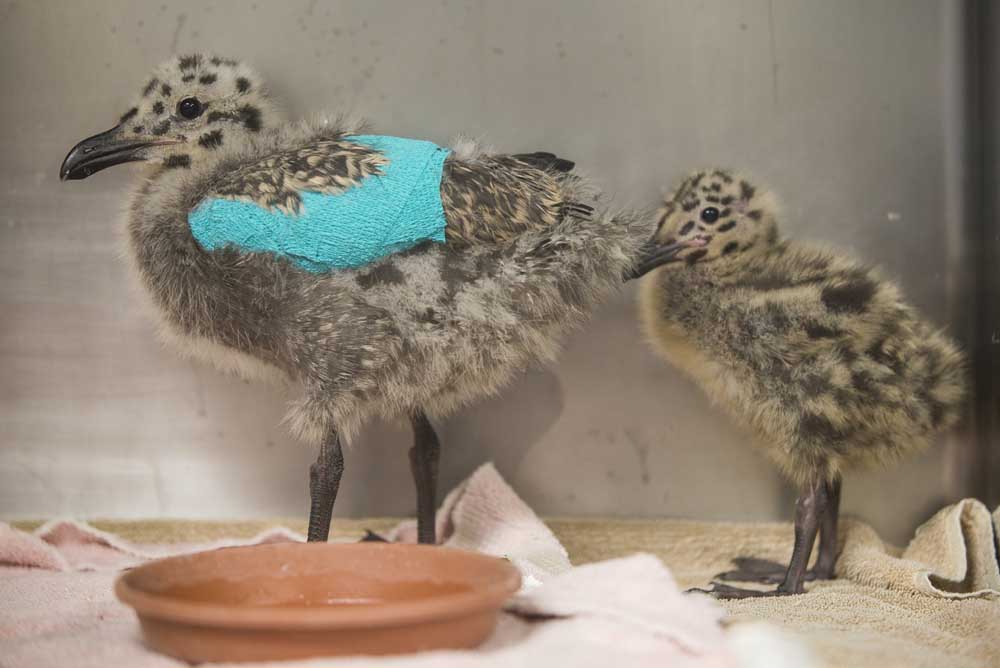Birds at rest
Published 2:48 pm Friday, August 21, 2015

- Western gull chicks in their cage.
Many of the birds that wind up at the Wildlife Center of the North Coast have been hit by cars, tangled in fishing line or have swallowed plastic.
Others are simply hungry.
“Right now, the oceans are really warm, so everything is starving to death,” said Josh Saranpaa, the assistant director of the nonprofit, volunteer-driven group that helps native birds and other wildlife.
The animals might look cute and cuddly but they are not pets. They’re wild.
“You have to be willing to get dirty,” he said. “You get bit and scratched all day long.”
One volunteer keeps track of the number of species she has seen at the center by adding stars in her guide book on the corresponding species page. She’s reached 99.
Here are 10 birds you might meet at the center.
The center has several of these birds, some of which can be released, and others that will have to remain at the center. One young cormorant wound up at the center after an eagle attacked him and dropped him in a tree. A taxi cab driver climbed the tree and brought the cormorant to the center, where he was treated for puncture wounds. Now, the little bird is receiving care for a respiratory infection. The bird, which is about a month old, may not be released due to developmental issues with its wings.
The center gets between six to 12 eagles a year. One juvenile bald eagle occupies a 100-foot flight cage, space to flex his wings and practice his flying skills before he graduates to open skies and unlimited vistas. Saranpaa and his wife caught the eagle, which was starving, at Cape Disappointment. But there’s one more test for the growing predator before his release. “We like to know they can catch live prey before we let them loose,” Saranpaa said.
As a water bird, the common loon has very particular needs the center must strive to meet. The center uses water pillows to accommodate the bird’s heavy body; its legs just aren’t meant to support its bulk on land, and can often look broken, Saranpaa said. The common loon the center has is about 3 pounds. Dark black feathers spotted with white distinguish them visibly. They’re also very vocal and, according to Saranpaa, who would know, they poop a lot.
The center has two northern saw-whet owls, petite, nocturnal birds that blend into their habitat, sticking to the shade on hot days. One of their owls won’t be released; it was hit by a car, blinding it in one eye. Now, he’s on an education permit, although he’s not glove trained, so he doesn’t go out much. But his companion, a fledgling, has a chance for release once he’s proved he can catch his own prey.
Western gull chicks are fluffy, camouflaged gray speckled with darker patches of feathers. They’re vulnerable looking, unlike the almost haughty adults they’ll become. Adult western gulls are white with gray wings and a yellow beak.
Brown pelicans employ a survival mechanism that makes them poor dinner guests. When they’re startled, they’ll regurgitate whatever they’ve eaten to lighten the load and help them escape faster. Handling the pelicans presents a challenge because any interaction leads to the birds losing their lunch … or whatever meal staff or volunteers have provided, Saranpaa said, so they feed them after they’ve taken care of all their other needs.
When ducklings come to the center in need of a mother figure, the center relies on a surrogate mother to raise them. That mother is an American wigeon. She couldn’t be released, so she took on a job. The duck reminds Saranpaa of the anxious rabbit in “Alice in Wonderland.” At first, she’s afraid of the ducklings, but they grow on her. “I really like her,” Saranpaa said. “These birds all have individual personality.”
Last year, the center received about 700 of these birds, and Saranpaa thinks they’ll get at least as many this year. The common murre is a black, white-bellied bird in the same family as auks and puffins.
Another water bird, the surf scoter the center is rehabilitating came in starving and developed a keel sore. Males have a distinctive head, with pale blue eyes and a red, orange-and-white beak, while the females are plainer. Surf scoters are a variety of duck.
Grandpa is a permanent resident of the center. He’s blind in his right eye. With his little tufts of eyebrow and cheek feathers, he reminds Saranpaa of an old man. The rhinoceros auklet is a close relative of puffins. “They feel like a little potato,” Saranpaa said of holding the small birds.




